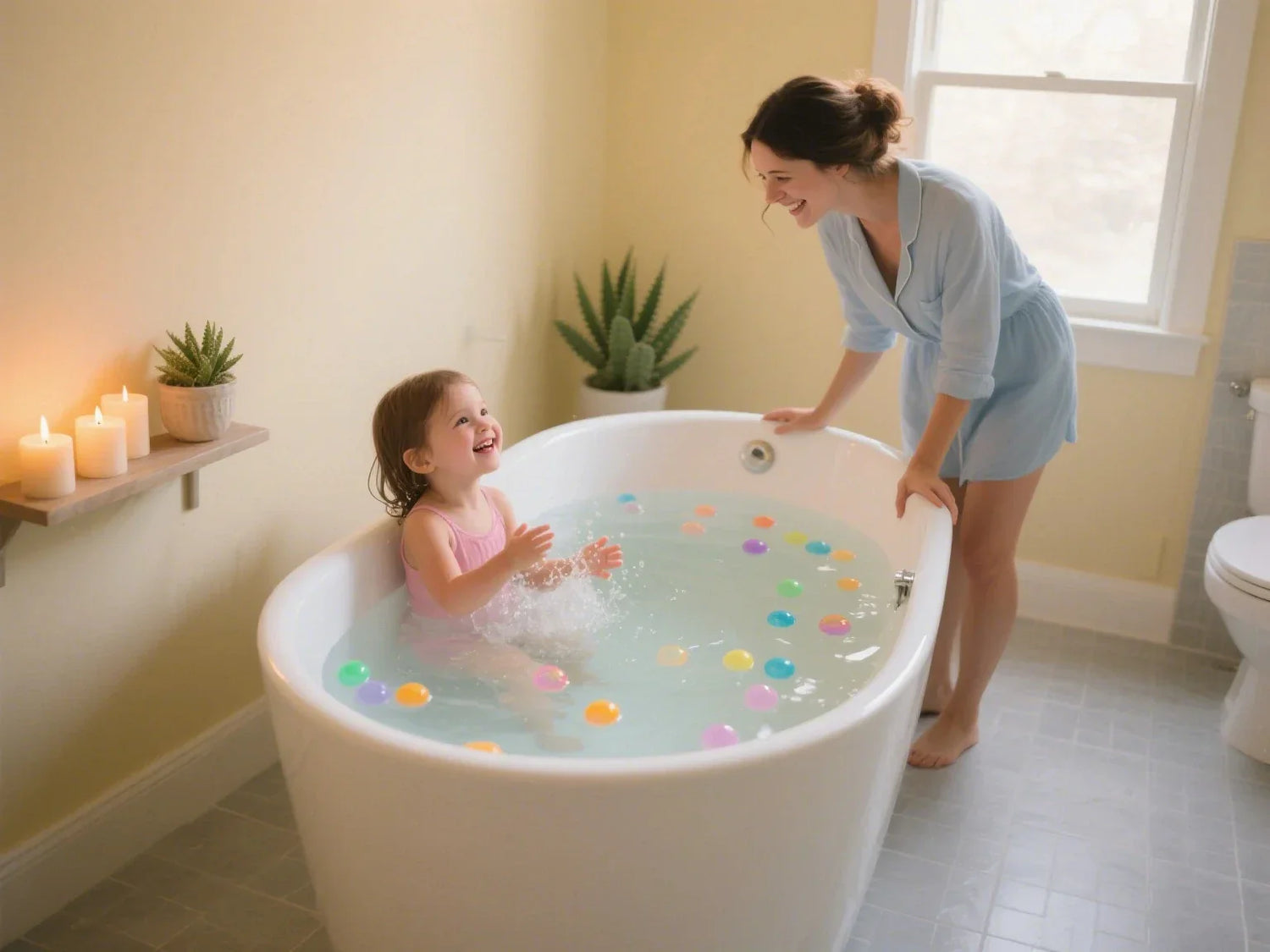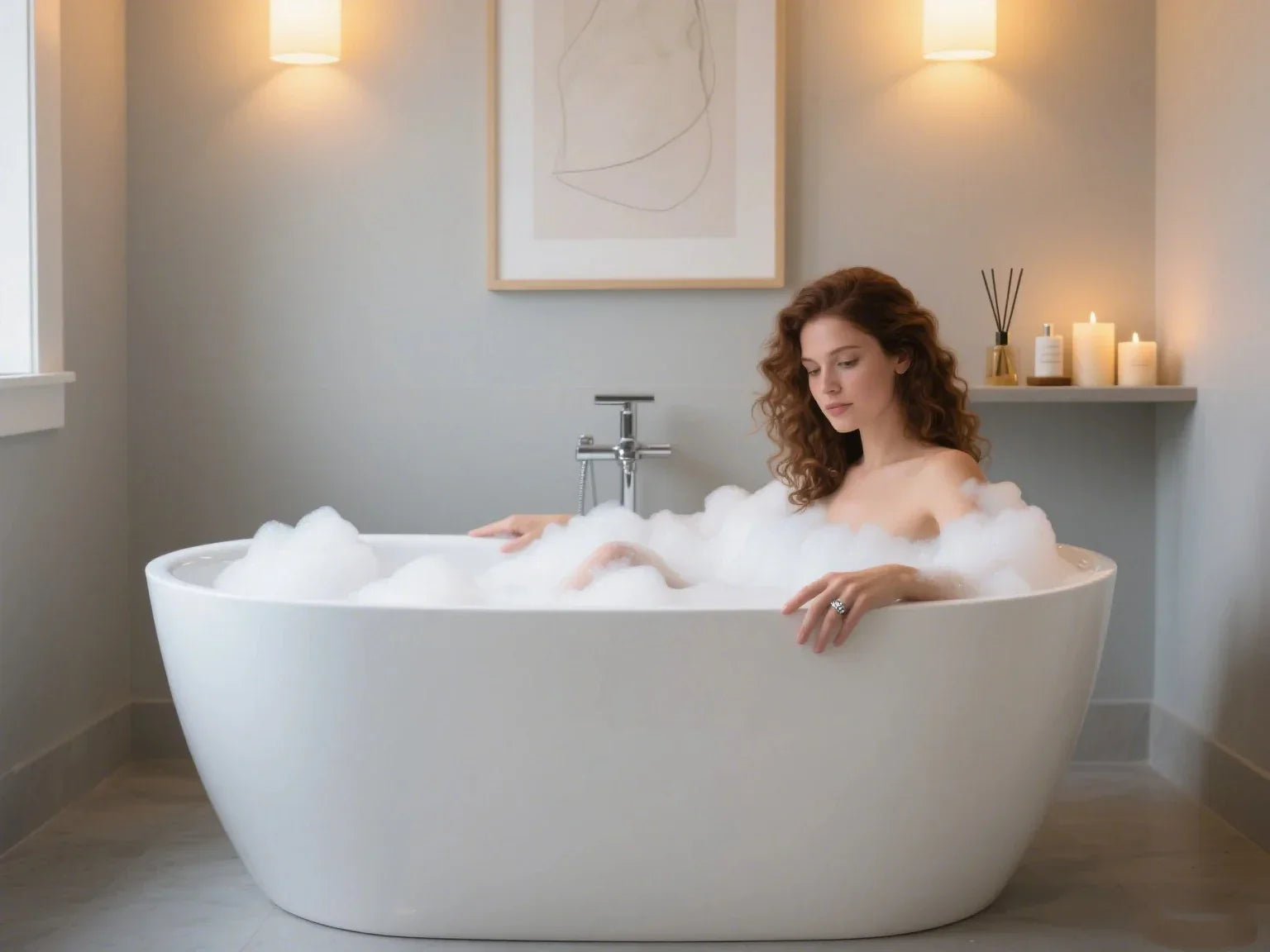Quick Reference: Acrylic vs Porcelain Tub Comparison Table
| Feature | Acrylic Tub | Porcelain Tub |
|---|---|---|
| Material | Acrylic-coated over fiberglass | Iron or steel with porcelain enamel |
| Weight | Lightweight (50–100 lbs) | Heavy (250–350 lbs, some even more) |
| Upfront Cost | Lower, budget-friendly | Higher purchase, installation, and repairs |
| Durability | Flexible, can scratch, repairable | Hard, scratch-resistant, can chip and rust |
| Design Options | Many colors, shapes, and sizes | Mostly classic shapes with glossy finishes |
| Heat Retention | Feels warm, keeps water hot longer | Cool to touch, cools water faster |
| Maintenance | Easy, gentle cleaners only | Easy, but chips need repair to prevent rust |
| Lifespan | 10–15 years with good care | 15+ years if maintained and chips avoided |
| Install Difficulty | DIY possible, easy upstairs | Pro install, may need floor reinforcement |
| Repair | DIY-friendly for minor scratches | Professional needed for chips, more costly |
| Eco-Friendliness | Low energy use, recyclable | More energy in making/shipping, hard to recycle |
| Slip Resistance | Non-slip models available | Usually slippery, mats/coatings needed |
What Are Acrylic and Porcelain Tubs Made Of?
Acrylic Tubs
Porcelain Tubs
Environmental Impact

Acrylic vs Porcelain Bathtubs: Key Differences
Durability: How Do They Handle Everyday Use?
- Can scratch with rough scrubbing or sharp objects.
- Most marks can be buffed out with home kits.
- Don’t use strong abrasives or scouring pads.
- Very flexible—a dropped object is less likely to cause a major crack.
- Highly resistant to scratches, thanks to their hard enamel coating, but can chip if something heavy is dropped.
- Exposed metal (after a chip) may rust quickly if not fixed.
- Enamel stays glossy for years if not abraded by harsh cleaners.
Heat Retention & Bathing Comfort
- Feels warm as soon as you touch it.
- Retains bath heat longer, making relaxing soaks more enjoyable.
- Great for families who want an inviting, cozy bath.
- Feels cool or cold at first. The metal sucks away heat from both water and skin.
- The bathwater tends to cool faster—unless the tub is pre-warmed.
- Some prefer the classic feel despite coolness.
- Acrylic tub: Water cooled to ~96°F
- Porcelain tub: Water cooled to ~89°F

Design, Color, and Style
- Available in modern, minimalist, or elaborate shapes—rectangle, oval, corner, soaking, and more.
- Many colors, although white is still most popular.
- Can mimic the look of fiberglass or even porcelain.
- Mostly classic shapes—rectangular, clawfoot, alcove, drop-in.
- Shiny, classic glossy finish; white is the standard.
- Heavier "clawfoot" and deep soaking styles often use porcelain over cast iron for vintage charm.
Sensory Differences: Feel and Sound
Faucet and Hardware Compatibility
- Acrylic tubs can be easily drilled for custom faucet placement, grab bars, or handheld sprayers. But they may not support the weight of heavy wall-mounted or freestanding faucets unless reinforced.
- Porcelain clawfoot tubs (especially over cast iron) are very sturdy and compatible with most faucet types, but retrofitting or drilling is much harder and may require specialized tools.
Installation & Ownership: What to Expect

Installation: Easy or a Project?
| Step | Acrylic Tub | Porcelain Tub |
| Weight to Carry | Light (easy for two adults) | Heavy (need multiple people) |
| Floor Reinforcement | Rarely needed | Sometimes required |
| Old Tub Removal | Easy (except if large/shower) | Hard, may need stairs prepped |
| DIY Friendly? | Yes—many handy homeowners do it | Usually needs a pro |
| Second Floor Suitable? | Yes, ideal | Only if floors can take weight |
- Acrylic: If you're remodeling upstairs, or your floors are old, acrylic is much safer.
- Porcelain: If you want a historic or very sturdy tub and your space can take the weight, porcelain works for ground floors/basements.
Daily Maintenance & Cleaning
- Use mild soap and a soft cloth.
- Wipe spills and stains quickly.
- Avoid bleach, scouring powders, or gritty pads.
- Mild cleaners work; avoid sharp scrubbers.
- If chipped, don’t wait—moisture on metal invites rust.
- Glossy finish can be dulled by strong abrasives.
Chemical Compatibility Table
| Cleaner Type | Acrylic Safe? | Porcelain Safe? |
| Bleach | No | No |
| Vinegar Solution | Yes | Yes |
| Baking Soda Paste | Yes (gentle) | Yes (gentle) |
| Abrasive Cleaners | No | No |
| Soft Scrub (non-abrasive) | Yes | Yes |

Maintenance Checklist
- Rinse after every bath
- Wipe dry once weekly
- Inspect for scratches or chips monthly
- Apply repair kits as needed
- Deep clean (gentle only) every 3 months
Repair and Restoration
- Small scratches: DIY kits cost $10–$30, fix in one afternoon.
- Deep gouges: Sometimes need a pro, but most minor marks are home-fixable.
- Finish can fade after years if harsh cleaners used, but “renewal” can be done.
- Chips or rust: Requires specialty paint, often $100–$300 or more for pro repair.
- Large areas of damage: May need full resurfacing, which is costly.
- A chip left untreated will rust and can lead to bigger issues.
Safety and Accessibility
| Feature | Acrylic Tub | Porcelain Tub |
| Slip Resistance | Textured options exist | Usually slick, mats help |
| Accessibility Mods | Easily drilled/modified | Harder, dense surface |
| Temperature Sensitivity | Comfortable | Cold to touch |
Cost and Value Analysis
Upfront & Long-Term Costs
Acrylic tubs: 30–50% less expensive than porcelain, from purchase through install.
- Entry-level acrylic: Great looks under $500.
- DIY installation saves even more.
Porcelain tubs: Higher purchase price, plus shipping, plus pro installer fees.
- Chips can mean expensive repairs later.
Long-Term Value & Resale
- An acrylic tub saves upfront but won’t impress buyers after a decade—unless kept scratch-free.
- A well-kept porcelain tub (especially a clawfoot or deep soaker) boosts home value in vintage or luxury markets.
| Cost Category | Acrylic Tub | Porcelain Tub |
| Purchase | $400 | $900 |
| Installation | $150 | $500 |
| Annual Maintenance Avg. | $30 | $50 |
| Typical Repairs (10 yrs) | $100 | $300+ |
| Total Estimated Cost | $1,050 | $1,950 |
Eco & Health Factors
Sustainability
- Acrylic: Lower energy in manufacturing and shipping. Some factories now use recycled content. Often recyclable at end of life.
- Porcelain: Metal requires mining and smelting, making a bigger environmental footprint; heavy shipping adds carbon. Most old steel/cast iron isn’t recycled in common renovations.
Health & Air Quality
- Acrylic: Cured in factory—little to no “off-gassing” after install.
- Porcelain: No chemical emissions once installed.
- Allergies: Both are non-porous, so mold and bacteria can be managed by regular cleaning.
Which Tub Fits Your Lifestyle?
- Young Families or Renters: Acrylic tubs are ideal. They're light, affordable, easy to replace, and safe for children thanks to their warm surface and non-slip options.
- Older Adults or Those with Mobility Concerns: Acrylic tubs can be modified with grab bars and textured bottoms, offering a safer bathing experience.
- Homeowners Renovating on a Budget: Acrylic wins again—DIY-friendly and easier to install upstairs.
- Luxury Seekers or Historic Homeowners: Porcelain tubs, especially cast iron clawfoot models, offer unmatched elegance and vintage appeal. They’re an investment in both function and aesthetics.
Real-World Results: Owner Stories and Case Studies
DIY Remodeler: Lightweight Wins
Historic Restorer: Classic Style, Heavy Lifting
Interactive “Best Tub Finder” Quiz
Q1: Is your bathroom above the first floor?
Yes: Consider acrylic for safety and simplicity.
Q2: Do you want to install it yourself?
Yes: Acrylic is your best bet.
Q3: Is classic, vintage style a must?
Yes: Porcelain or porcelain over cast iron wins.
Q4: Are you on a tight budget?
Yes: Acrylic tubs save money up front and with DIY repairs.
Q5: Is bathwater heat retention important for you?
Yes: Acrylic holds heat better and feels warmer.
Acrylic vs Porcelain Tub: What Material is Best for a Bathtub
| Feature | Acrylic Tub | Fiberglass Tub | Porcelain Tub |
| Material Composition | Acrylic sheets bonded to reinforced fiberglass | Fiberglass reinforced with polyester resin | Steel or cast iron base coated with porcelain enamel |
| Weight | Light (50–100 lbs) | Very light (40–70 lbs) | Heavy (250–350+ lbs) |
| Upfront Cost | Moderate ($400–$800) | Lowest ($300–$500) | High ($700–$1,500+) |
| Installation Difficulty | DIY-friendly | Very DIY-friendly | Requires pro install |
| Heat Retention | Excellent | Poor | Moderate |
| Durability | Resistant to cracks, scratches buffable | Cracks/chips easily, less durable | Very scratch-resistant, but chips can rust |
| Surface Feel | Smooth, warm to touch | Textured, may feel rough over time | Cool, very hard/glassy finish |
| Design Variety | High – many shapes/colors | Moderate – limited styles | Low – mostly classic styles |
| Scratch Resistance | Moderate (repairable) | Low | High |
| Chip Resistance | Moderate | Low | Low (chips expose metal) |
| Maintenance Needs | Gentle cleaners only | Easy but stains/fade over time | Easy but avoid harsh abrasives |
| Typical Lifespan | 10–15 years | 5–10 years | 15–30+ years |
| Eco-Friendliness | Energy-efficient to ship, recyclable | Least sustainable | Energy-heavy to produce, hard to recycle |
| Best For | Upper floors, DIYers, families | Budget-conscious short-term installs | Classic looks, long-term/permanent homes |
Frequently Asked Questions
1. Are acrylic or porcelain tubs better?
2. Can you refinish a chipped porcelain tub?
3. Which bathtub material lasts longer?
4. How do you safely clean each tub type?
References
- U.S. Environmental Protection Agency (EPA). Sustainable Management of Materials. https://www.epa.gov/
- U.S. Department of Housing and Urban Development (HUD). Residential Building Codes and Safety Guidelines. https://www.hud.gov/program_offices/housing








Leave a comment
This site is protected by hCaptcha and the hCaptcha Privacy Policy and Terms of Service apply.